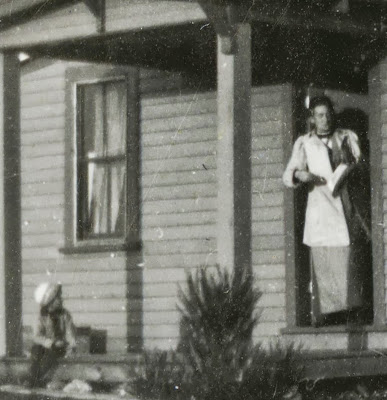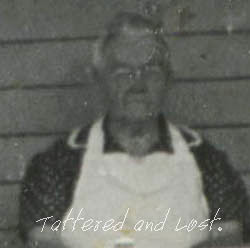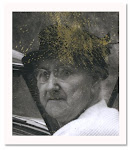This is not the first time I've reposted this image or the information with it, but this is the first time I've been able to say something that makes me smile this much. This photo has been used on the book jacket of best-selling author James Bradley's new book The China Mirage. Today my father had the honor of meeting Mr. Bradley and getting his book signed at a fascinating speaking engagement. I think my dad and I are going to be fighting over who gets to read the book first.
Mr. Bradley clearly connected the dots of so many things I found confusing in history about the US and China when I was growing up. The misperception we have been taught about China and where it came from made me think of the same craziness that is going on today. We're just as gullible today listening to politicians and much of the media. In some respects it feels a little hopeless, but where there's logic I think freedom follows.
Anyway, this was one of those days that I'll always remember my dad's smile. And when we left the event I said to my dad, "That was so very cool!" My dad responded with, "Yes, that was very very cool." I don't think I've ever heard my dad say "cool" before.
________________
My reason for reposting this is because of information that has been provided to me about what finally became of the USS Puget Sound. You can read it at the end of this post as an update. Thank you Gavin Cheng for contacting me!
________________
Here's something a little different. This is from my father's collection of photos taken when he was in Hong Kong following the end of World War II.
This is the USS Puget Sound(CVE 113) at anchor in Hong Kong harbor, December 1945.
USS Puget Sound (CVE-113)
Builder: Todd Pacific Shipyards
Laid down: 12 May 1944
Launched: 20 September 1944
Commissioned: 18 June 1945
Decommissioned: 18 October 1946
Reclassified: Helicopter Carrier, CVHE-113 on 12 June 1955, Cargo Ship and Aircraft Ferry, AKV-13
Struck: 1 June 1960
Fate: Sold 10 January 1962, and scrapped in Hong Kong 1962
General Characteristics
Class and type: Commencement Bay-class escort carrier
Displacement: 10,900 long tons (11,100 t), 24,100 long tons (24,500 t) full load
Length: 557 ft (170 m)
Beam: 75 ft (23 m)
Draft: 32 ft (9.8 m)
Propulsion: 2-shaft Allis-Chambers geared turbines, 16,000 shp
Speed: 19 knots (22 mph; 35 km/h)
Complement: 1,066
Armament: 2 × 5 in (130 mm) guns (2×1), 36 × 40 mm AA guns
Aircraft carried: 34
Service Record
Part of: US Pacific Fleet (1945-1946), Pacific Reserve Fleet (1946-1960)
Operations: Operation Magic Carpet
USS Puget Sound (CVE–113) was a Commencement Bay-class escort carrier of the United States Navy.
She was laid down on 12 May 1944 at Todd-Pacific Shipyards, Inc., Tacoma, Washington; launched on 20 November 1944; sponsored by Mrs. Bert A. Teats of Sheridan, Oreg.; and commissioned on 18 June 1945 at Tacoma, Captain Charles F. Coe in command.
Service History
After trials and fitting out in the Puget Sound Naval Shipyard, Puget Sound steamed south on 6 July 1945 for shakedown out of San Diego, Calif., where she embarked Marine Air Group 6. She departed San Diego on 8 September for brief training in the Hawaiian Islands before proceeding to support the occupation of Japan.
Puget Sound entered Tokyo Bay on 14 October 1945. Her aircraft joined in the show of strength and conducted antimine patrols in support of the landings of the 10th Army at Matsuyama and Nagoya. Thence tactical training took her to the Philippines, Hong Kong, and the Marianas. Loading surplus aircraft in Apra Harbor, Guam, she put to sea on 6 January 1946 en route to Pearl Harbor, where she offloaded the surplus aircraft. At San Diego on 23 January, Marine Air Group 6 was detached and Puget Sound prepared to serve as a "Magic Carpet" home for Pacific war veterans.
From February-May 1946, Puget Sound made two "Magic Carpet" runs between San Diego and Pearl Harbor and one between Alameda, California and Okinawa, transporting 1,200 troops and surplus aircraft.
She steamed north on 24 May 1946 to prepare for inactivation, entering Puget Sound Naval Shipyard on 1 June. Decommissioning there on 18 October, she entered the Pacific Reserve Fleet at Tacoma. Her hull classification and number were changed to CVHE–113, effective 12 June 1955, and then to AKV–13, cargo ship and aircraft ferry. Struck from the Naval Vessel Register on 1 June 1960, she was sold for scrap on 10 January 1962 to Nicholai Joffee Corp. (SOURCE: Wikipedia)
As to the boat in the foreground, that is a Chinese Junk:
A junk is an ancient Chinese sailing vessel design still in use today. Junks were developed during the Han Dynasty (206 BC–220 AD) and were used as sea-going vessels as early as the 2nd century AD. They evolved in the later dynasties, and were used throughout Asia for extensive ocean voyages. They were found, and in lesser numbers are still found, throughout South-East Asia and India, but primarily in China, perhaps most famously in Hong Kong. Found more broadly today is a growing number of modern recreational junk-rigged sailboats. (SOURCE: Wikipedia)
To read more about the history of the Chinese Junk click here.
UPDATE: from Gavin Cheng
UPDATE: from Gavin Cheng
I found out about this ship interviewing my Uncle, who took delivery of the USS Puget Sound and USS Cyprus in San Diego in the 60's in order to take them back (strangely enough) to Hong Kong, where our family business included salvage and processing. Absolutely every part of the ship was made use of, the steel was used to form rebars which were used in the rebuilding and expansion of Hong Kong.
My Uncle, and engineering major at UC Berkley, was tasked with figuring out how to convert the aircraft launchers into an aluminum extrusion presses after his father noticed the similarities in design.
The family company, Chiap Hua, was involved in all manner of industry pre and post war. As a company philosophy they limited all military supply production to defensive and community based product such as helmets, water canteens etc.
Despite this, the founding brothers received word that the Japanese command planned to incarcerate them due to their having "aided the British", resulting in a flight by foot from Hong Kong all the way back to Chiu Chau in China where they stayed until the end of the war.
As the war was wrapping up, they returned to Hong Kong, re-instated the factories, and joined efforts to rebuild the city. At that time the Hong Kong harbour was unusable for commerce due to the massive number of bombed and sunken ships. Seeing an opportunity, my grandfather and grand uncles were able to secure a contract with the government to clear the harbour. They were paid by the ship, and the government provided free storage for the wrecks.
Under maritime law, the salvage belonged to them. As the company completed the harbour clearing, Hong Kong was able to be opened as a shipping port again, but there was a steel shortage. Steel was previously supplied by Japan, which was in desolation. Chiap Hua began converting the steel in the ships to rebars, crucial to the rebuilding of Hong Kong. My Uncle recalls trucks lined up with fists of cash buying the rebars as soon as they rolled out of the factory.
The interesting cycle is that after being driven out by the Japanese occupation, they were able to not only clear the harbour for commerce, but used the materials from the ships to rebuild the city.
The image of the USS Puget Sound was taken at almost the same time this was taking place, so it is interesting that in the fullness of time it found its way back to Hong Kong.




















































